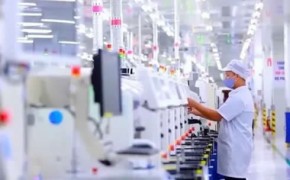越通社消息称,从投资资金来看,新加坡仍是越南最大投资资金来源地,但从投资项目来看,中国位居第一,大量外资正在从中国涌入越南。
5年来,中国一直成为对越南投资最多的5个国家之一。据越南计划投资部外国投资局的统计数据,今年前7月,新加坡对越南投资资金近65.2亿美元,占越南投资总额的近36.2%,同比增长79%,成为越南最大投资来源地。中国香港以投资额21.9亿美元,占投资总额12.2%,同比增长1倍,位居第二。其次为日本和中国。尽管如此,中国新投资项目数量位居第一,占越南投资项目总数量的近30%,同比增长6倍,同时在对越投资的146个投资伙伴中位居第一位。
越南计划与投资部部长阮志勇在最近召开的政府7月例行会议上强调,“吸引外国直接投资资金(FDI)继续大幅增长。特别是,由于认真、仔细选择吸引投资,外国直接投资资金流动的质量急剧提高。”
越南计划与投资部外国投资局表示,截至2024年7月,越南外商直接投资注册资金总额超过180亿美元,比2023年同期增长10.9%。2024年前7个月,注册投资资本和已实现投资资本同比继续增长,增幅分别为10.9%和8.4%。其中,到位资金超过125.5亿美元,同比增长8.4%。这是5年来(2020-2024年)7个月内实现的FDI资本最高金额。
计划投资部部长阮志勇评价说,容易看出的积极一点就是来自中国的外资中,许多来自中国技术、电气-电子、加工、制造、基础设施、可再生能源和电动车等领域的国大规模集团。
实际表明,若此前中国的外资主要流入实木家具加工和生产、钢材、皮革鞋、服装、食品加工和塑料包装等行业,最近几年,中国资金主要流入高技术产业、工业生产零部件、配件,电子,汽车,绿色能源等等。
截至目前,中国许多数亿美元的项目,甚至100亿美元的项目已在越南展开,如歌尔、比亚迪、Radian、北京波泰克科技(BroTex)、闻泰、得力、天合光能等集团的项目。
越南统计总局数据显示,工业生产保持积极增长势头。预计7月份工业生产指数环比增长0.7%,同比增长11.2%。2024年前7个月,整个工业生产指数预计比去年同期增长8.5%。值得注意的是,全国60个地方工业生产指数上升,只有3个地方下降。
越南外国投资者协会主席阮卖评价说,越中两国贸易关系在货物进出口结构中拥有互补性。从中国流入越南的资金日益增加的原因在于该国国内市场的优势。许多国际组织预测,在这种动力的推动下,未来一段时间内实际支付的FDI资本将会更高。
同时,越南的营商环境也受到FDI商界的高度评价,许多大型项目的竣工是迎接未来FDI投资浪潮的条件,尤其是外国投资者对越南的半导体产业非常感兴趣。
越南计划与投资部部长阮志勇强调了促进吸引外国直接投资资本流动的关键解决方案。他表示,计划与投资部将紧急审查,并彻底消除和及时处理体制、法律和行政程序中的困难和障碍,以创造突破性动力;同时,重点吸引加工、制造、电子、半导体等行业规模化、优质化、高技术含量的外商直接投资项目。
越南计划与投资部部长阮志勇认为,政府与研究院、学校与企业之间的合作是越南科技领域前所未有的发展和创新的杠杆。当由计划投与资部提交的《到2030年半导体行业人力资源开发项目和2050年愿景》获得政府批准时,这种合作也将得到很大的支持。
根据独立信用评级数据源和指数提供商标准普尔全球的报告,2024年7月越南制造业采购经理指数(PMI)达54.7点,连续4个月上升,为2018年11月以来的最高水平。消费品、中间产品和基本投资品等所有领域均取得显着改善。
越南加工制造业中的许多重要行业吸引了大量劳动力,生产结果高于去年同期水平,如电力和电子工业,木材及木制品工业,纺织、服装和制鞋业,钢铁,化学品,橡胶等。此外,电力生产和配送业同比增长,继续满足人民生产、经营和消费的需要。积极的变化有助于为外国投资者创造乐观情绪,让他们放心在越南开展投资。
越南工贸部副部长潘氏胜女士表示,上述结果是来自于国内工业企业的产能发生了积极变化,并为在不久的将来抓住机遇进军新市场做好准备。与此同时,政府和政府总理对公共投资资金到位,重点工业项目实施等生产支持政策也有力和积极地增强了国内制造企业和外国企业的信心;在吸引外国投资(FDI)资金到位方面取得积极成果也有助于提高国内生产能力等。政府、各部委、地方与企业同行,为企业抓住市场机遇、恢复出口订单创造条件,特别是在纺织、皮革鞋类、电子、农产品、食品等越南重点出口领域。
不过虽然有所改善,但越南国内工业生产健康状况依然薄弱,近期工业生产瓶颈问题尚未得到有效克服。潘氏胜副部长表示,生产仍然在很大程度上取决于外部因素,特别是外资部门。国内工业附加值仍然较低,辅助产业不发达,国内高技术含量工业产品不多。
与此同时,工业生产尚未完全恢复,三个地方工业生产出现负增长。部分主力工业生产产业仍然同比下降,例如智能手机、电视、汽车等以及部分出口产品,例如鞋类、木材、手机和配件虽然复苏但尚未恢复到2022年的峰值。
同时今年最后几个月,部分国家冲突局势依然复杂难料,贸易伙伴复苏仍缓慢,全球供应链、生产链可能出现中断风险,出口活动继续依赖部分外资部门的市场和产品。此外,越南对欧盟或美国的主要出口商品仍可能面临贸易防御调查和技术壁垒的压力。国内市场复苏依然缓慢,国内价格指数仍面临多项政策的压力。
因此,潘氏胜女士认为,需要采取许多同步的、长期的、扎实的措施来确保工业行业稳定、可持续的增长。具体来说,工贸部将部署4组措施,继续促进工业生产。
According to the Vietnam News Agency, Singapore is still Viet Nam's largest source of investment funds in terms of investment funds, but in terms of investment projects, China ranks first, and a large amount of foreign capital is pouring into Viet Nam from China.
For five years, China has been one of the top five countries investing in Viet Nam. According to statistics from the Foreign Investment Bureau of the Ministry of Planning and Investment of Viet Nam, in the first seven months of this year, Singapore's investment in Viet Nam was nearly US$6.52 billion, accounting for nearly 36.2% of Viet Nam's total investment, a year-on-year increase of 79%, making it the largest source of investment in Viet Nam. Hong Kong, China, ranked second with an investment of US$2.19 billion, accounting for 12.2% of the total investment, a year-on-year increase of 1 times. This is followed by Japan and China. Despite this, China ranked first in the number of new investment projects, accounting for nearly 30% of the total number of investment projects in Viet Nam, a six-fold year-on-year increase, and ranked first among the 146 investment partners investing in Vietnam.
Viet Nam's Minister of Planning and Investment, Nguyen Chi Dung, stressed at a recent regular meeting of the government in July that "attracting foreign direct investment (FDI) funds continues to grow significantly." In particular, the quality of FDI flows has increased dramatically as a result of careful and careful selection to attract investment. ”
As of July 2024, the total registered capital of foreign direct investment in Viet Nam exceeded US$18 billion, an increase of 10.9% over the same period in 2023, according to the Foreign Investment Agency of the Ministry of Planning and Investment of Viet Nam. In the first seven months of 2024, registered investment capital and realized investment capital continued to grow year-on-year, increasing by 10.9% and 8.4%, respectively. Among them, the funds in place exceeded 12.55 billion US dollars, a year-on-year increase of 8.4%. This is the highest amount of FDI capital achieved in 7 months in 5 years (2020-2024).
Minister of Planning and Investment Nguyen Chi Dung commented that the positive point that it is easy to see is that many foreign investment from China comes from China's large-scale state-owned groups in the fields of technology, electrical and electronics, processing, manufacturing, infrastructure, renewable energy and electric vehicles.
Facts show that if China's foreign capital mainly flowed into solid wood furniture processing and production, steel, leather shoes, clothing, food processing and plastic packaging industries, in recent years, China's capital has mainly flowed into high-tech industries, industrial production parts, accessories, electronics, automobiles, green energy and so on.
Up to now, many projects in China with hundreds of millions of dollars, or even $10 billion, have been launched in Viet Nam, such as Goertek, BYD, Radian, Beijing BroTex, Wingtech, Deli, Trina Solar and other groups.
According to the General Statistics Office of Viet Nam, industrial production maintained a positive growth momentum. The industrial production index is expected to rise 0.7% month-on-month and 11.2% year-on-year in July. In the first seven months of 2024, the overall industrial production index is expected to increase by 8.5% compared to the same period last year. It is worth noting that the index of industrial production rose in 60 places across the country, while only 3 places declined.
Nguyen Sell, President of the Viet Nam Association of Foreign Investors, commented that the trade relations between Vietnam and China are complementary in the structure of import and export of goods. The reason for the increasing flow of money from China into Viet Nam is the strength of the country's domestic market. Many international organizations predict that the actual FDI capital disbursed will be higher in the coming period, driven by this dynamic.
At the same time, Viet Nam's business environment is also highly valued by the FDI business community, and the completion of many large-scale projects is a condition for the future wave of FDI investment, especially foreign investors are very interested in Viet Nam's semiconductor industry.
Viet Nam's Minister of Planning and Investment, Nguyen Chi Dung, highlighted key solutions to facilitate the attraction of FDI capital flows. He said that the Ministry of Planning and Investment will urgently review and completely remove and deal with difficulties and obstacles in institutional, legal and administrative procedures in a timely manner to create breakthrough momentum; At the same time, it will focus on attracting large-scale, high-quality, high-tech foreign direct investment projects in processing, manufacturing, electronics, semiconductors and other industries.
Nguyen Chi Dung, Minister of Planning and Investment of Viet Nam, believes that cooperation between the government and research institutes, schools and enterprises is an unprecedented lever for development and innovation in the field of science and technology in Viet Nam. This cooperation will also be greatly supported when the "Human Resource Development Project for the Semiconductor Industry by 2030 and Vision 2050" submitted by the Ministry of Planning and Investment is approved by the government.
According to a report by S&P Global, an independent credit rating data source and index provider, Viet Nam's manufacturing purchasing managers' index (PMI) reached 54.7 points in July 2024, rising for four consecutive months and the highest level since November 2018. Significant improvements were made in all areas, including consumer goods, intermediate goods and basic investment goods.
Many important industries in Viet Nam's processing and manufacturing industry have attracted a large number of laborers, and the production results are higher than the same period last year, such as the power and electronics industry, the wood and wood products industry, the textile, clothing and footwear industry, iron and steel, chemicals, rubber, etc. In addition, the electricity production and distribution industry increased year-on-year, continuing to meet the needs of the people's production, operation and consumption. Positive changes help create optimism for foreign investors and reassure them about investing in Viet Nam.
Ms. Phan Thi Thanh, Deputy Minister of Industry and Trade of Viet Nam, said that the above results are due to positive changes in the production capacity of domestic industrial enterprises and are ready to seize opportunities to enter new markets in the near future. At the same time, the government and the prime minister's production support policies such as the availability of public investment funds and the implementation of key industrial projects have also strongly and positively enhanced the confidence of domestic manufacturing enterprises and foreign enterprises; Positive results in attracting foreign investment (FDI) funding also contribute to increasing domestic production capacity, among other things. The government, ministries and commissions, localities and enterprises work together to create conditions for enterprises to seize market opportunities and resume export orders, especially in key export areas Viet Nam such as textiles, leather footwear, electronics, agricultural products, and food.
However, despite some improvements, the health of Viet Nam's domestic industrial production is still weak, and the bottleneck problem of industrial production has not been effectively overcome in the near future. Vice Minister Phan Thi Seng said that production still depends largely on external factors, especially the foreign sector. The added value of domestic industry is still low, auxiliary industries are underdeveloped, and there are not many high-tech industrial products in China.
At the same time, industrial production has not yet fully recovered, and industrial production in three places has experienced negative growth. Some major industrial production sectors such as smartphones, TVs, automobiles, etc., as well as some exports, such as footwear, timber, mobile phones and accessories, have recovered but have not yet recovered to their peaks in 2022.
At the same time, in the last few months of this year, the conflict situation in some countries remains complex and unpredictable, the recovery of trading partners is still slow, the global supply chain and production chain may be disrupted, and export activities continue to rely on the markets and products of some foreign sectors. In addition, Viet Nam's main exports to the EU or United States may still face pressure from trade defense investigations and technical barriers. The recovery of the domestic market is still slow, and the domestic price index is still under pressure from a number of policies.
Therefore, Ms. Poon believes that many simultaneous, long-term and solid measures are needed to ensure stable and sustainable growth of the industrial sector. Specifically, the Ministry of Industry and Trade will deploy four sets of measures to continue to promote industrial production.




